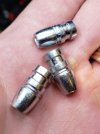jordanka16
Active Member
Yup, using a ladle, and I leave a good size puddle on top, or at least I think.Are you using a ladle as God and nature intended or one of those bottom pour monstrosities? Are you letting a generous amount of alloy run over the sprue plate? It all helps get the mould up to temp. I've seen some videos of guys that were self-proclaimed experts trying cast and they didn't leave enough of a puddle to say so. Be generous with the alloy. It'll go back into the pot after it serves it's purpose of heating up the mould.
Perhaps next time I cast I should take a video to let people examine it. I've never had any trouble from my iron or aluminum molds, but perhaps there's some error I'm making.

